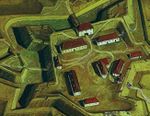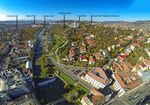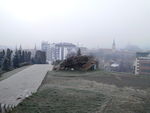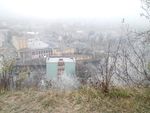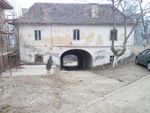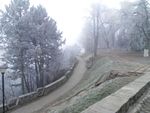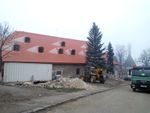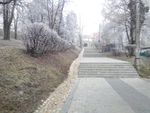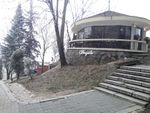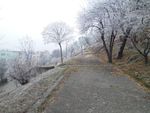Green Infrastructure 2014 Group G - Case Study 4
---> back to group page working group G
Cetatuia Hill
| Name | Cetatuia Hill | |
| Country | Romania | |
| City | Cluj-Napoca | |
| Authors | Papiu-Zoran Catalina | |
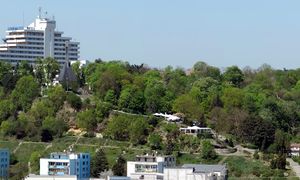
| ||
|
| ||
Rationale: Why is this case interesting?
Cetatuia hill is located nearby the city center of Cluj-Napoca and it is the place where the most beautiful panorama of the city can be enjoyed in a natural settlement. When the Austrian troops left, the hill was given back to the city and became the promenade place of the citizens as well as a touristic objective for foreigners.
Even though it has a lot of history as background, a privileged location (near Somes which is the main river of the city) and is listed as one of the major attraction of the city, in the last years it has been left in a cone of shade. Existing constructions turned into abandoned places almost in ruin, more than 50% of the hill side is not even practicable (landslides, lack of alleys) and citizens have lost their interest in enjoying this piece of nature.
In the context of urban revitalization a long term GI planning for Cetatuia hill would determine the reintegration of this site into the city's scale of values and would set and example how the functional and aesthetical principles applied in the process of rehabilitating an unexploited existing site can contribute to the city's revitalization.
Author's perspective
I have started my professional training as a computer programmer but discovered that I love nature more than computers therefore I have graduated as a landscape architect in 2009 and started to work in the green roof systems field. Cluj-Napoca is my hometown and the place where I currently live. Over the years I had the opportunity to visit a lot of beautiful places around the world and saw how other managed to highlight their cities potential and I want the same for mine. I think of my city as a diamond still unpolished at its true value and Cetatuia Hill is one of its emblems. Given the nature of my profession I feel that it is in our hand to contribute to the change we want therefore my concern is to revitalize the existent green spaces and to create new ones as well.
Landscape and/or urban context of your case
What was once a place for growing wines was transform starting with 1716 into a fortress (cetatuia is the Romanian name for fortress) with strategic and military purposes. The height of the hill allowed the army to oversee the whole city and its surroundings. The beautiful view and its appealing to tourists lead to the construction in 1969 of one of the biggest and modern hotel of that time.
Nowadays Cluj-Napoca is a crowded city with a lot of grey buildings and bad traffic struggling with the lack of green spaces (only 20 m2/inh well bellow the average of 50 m2 indicated by the EU). You can feel this mostly during the warm and sunny days when people get crowded in the central city park (which is in reality a public garden having only 1 ha).
In Cluj-Napoca green spaces are not interconnected and many of public gardens inside the neighborhoods are not even inviting therefore people are not attracted anymore by the nature in their city.
- Illustrations
Analytical drawings
- Analytical Drawings
Green Infrastructure benefits for this site
In this case GI would play an important role in terms of restoration and preservation. It is very important that the Cetatuia Hill remains a green public place. Given the lack of green spaces located inside the city this site represents a key player in the Urban Heat Island mitigation. It is also a place with very high potential in what concerns economic and social benefits.
Potential for multifunctionality
Cetatuia Hill is a perfect place where natural landscape can fit recreational activities as well as housing and tourism.
Through the GI approaches the local fauna and flora would be preserved while the invasive plants would be removed making place for new planted areas (using representative native species). The vegetation will help solving the existent issues of erosion and stormwater management.
A proper infrastructure for this site (multiple acces, walkways, sitting places, bicycle lanes etc.) will make Cetatuia Hill more attractive for citizens as a daily/weekly recreational place and more interesting for tourists. Investors will be also attracted in making business and revitalize the existing tourism units.
The restoration works will bring an increased value to the existing properties as well as to the the life quality.
Cetatuia Hill can be seen as a destination itself but it can be at the same time a chain loop in other cultural or blue-green circuits in the city.
Projective drawings
- How would you like this case to change in the near future? (in 1-2 years)
- you may add a short explanation here
- And how could it look like in 10-15 years?
- you may add a short explanation here
- Projective Drawings
- Yourdrawing.jpg
projective drawing
- Yourdrawing.jpg
projective drawing
- Yourdrawing.jpg
projective drawing
- Yourdrawing.jpg
projective drawing
Summary and conclusion
- 100 words approx.
Image Gallery
- Image Gallery
References
http://www.cluj.travel/in-cautarea-cetatuii-pierdute/
http://blog.cluj.info/opinii/cetatuia/
http://metropotam.ro/Locuri-de-vizitat/Cetatuia-Clujului-art3151656113/
Iuliu Buta, Petru Dan Idu, Nicolae Edroiu. Bucureti 1980. Cluj Ghid turistic al judetului.
ProfImage, Dan Trif, Nicoleta Anca. Cluj-Napoca 2002. Clujul vechi si nou.
About categories: You can add more categories with this tag: "", add your categories
